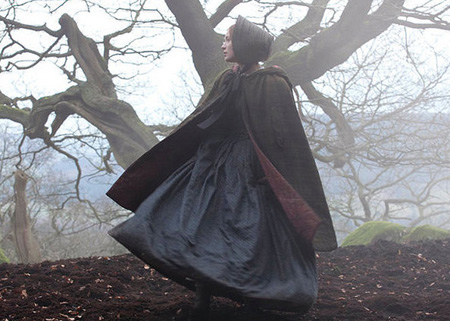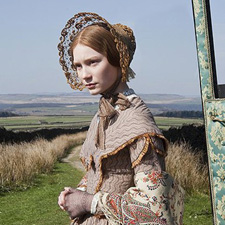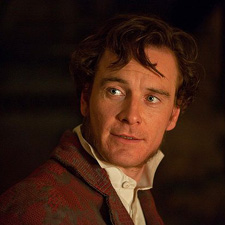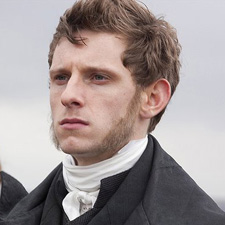Click HERE to go directly to Jan’s review…
Jan Chats with Cary Fukunaga & Mia Wasikowska
about their new film adaptation of
Charlotte Bronte’s classic JANE EYRE

Mia Wasikowska as "Jane Eyre."
All Photo Credits: Laurie Sparham/Focus Features
American director Cary Fukunaga (pronounced “Fu-kun-a-ga”) and his Australian star Mia Wasikowska (pronounced “Vash-i-kov-ska”) came to Chicago on March 6 to show their new version of
JANE EYRE (2011) at our Gene Siskel Film Center’s annual “European Union Film Festival.”
The next day (3/7/11), I met with them the Peninsula Hotel. There were two other local critics in the room with us. We had all been at the screening/Q&A the night before.
Here‘s my part of the conversation. I jumped in right after Cary said he had seen the Stevenson version of
JANE EYRE (1944) as a kid, but hadn’t seen it recently…
|

Cary Fukunaga
|

Mia Wasikowska
|
Cary: I never really watched the other versions. I’m aware of them, but the Bob Stevenson's version [starring Joan Fontaine as Jane and Orson Wells as Mr. Rochester] is the only one I knew of growing up.
And even when I signed the film, I didn't realize there were so many versions, and I actually think most people haven't seen them either. So I didn't really care about what anyone else had done, because I knew I wasn't going to be doing what they did, and I wasn't going to do “different things” just to be different. I didn't want to be forced, or be too aware of what they had done.
Jan: What about you, Mia? Had you seen the other film versions?
Mia: No, kind of similar. I was partially overwhelmed by how many there were. I didn't really know where to start, and then I also I didn't want to be influenced by anything, even in a way that I didn't realize.
Jan:
Well, okay, so I can be your “brain trust.” I saw JANE EYRE
(1944), aka the Stevenson version, way back when. And then I saw
JANE EYRE (1996), the one that Franco Zeffirelli did with Charlotte Gainsbourg and William Hurt, when it came out in 1996. That one was very broadly played here in the USA.
So I saw your version at a critics screening in February. Then I went back and watched both of those films again, and I also went back & read the novel again. I hadn’t read it since high school, which is really way far back!
So just so you know: the main difference in your version is the treatment of St. John Rivers (pronounced “Sin-Jin”). Jane’s time in the Rivers Parsonage doesn't appear in either of those two movies at all. In Stevenson's version…
Cary:
They make Rivers a doctor, right?
Jan:
Yes, they make him the doctor at Lowood. He’s the person who cares for Helen Burns. That's how Jane knows him. So there are no romantic implications at all with that character. And in the Zeffirelli version, he's the person who calls Jane back to Gateshead when Mrs. Reed is dying.
So tell us about the Rivers Parsonage, and why you decided to locate so much of your film there.
Cary:
If you want to be totally faithful to the book, you’ve got to treat that part of the story. The conversations about marriage go on and on and on and on. You're like: “Come on, guy, get the clue; she doesn't really want to marry you.”
But it works in this case by rearranging the structure of the film to make that the present tense. You can get the elements you need from that relationship [between Jane & “SinJin”] without it slowing down the end of the film, because we've covered it throughout.
Jan:
So when you were doing the casting, were you aware that Mia had once been Jamie Bell's “forest wife” in
DEFIANCE?
Cary:
I was vaguely aware of it, and then I became really aware of it in rehearsals when they kept referring to it.
Jan:
But Mia and Jamie Bell have really good chemistry, so you gave your Jane a real romantic choice by casting him. She is required to make a real choice about her future in your version, which the two earlier versions don't give her.
Mia:
The relationship is so interesting, and the way that Jamie plays it is so brilliant. It's a fine line between making “SinJin” really unlikeable, or having some sympathy for him or understanding of him, and Jamie does it brilliantly.
Jan:
And this gives the story a whole different texture?
Mia:
Yeah, it gives a different energy to Rochester, a completely different energy—almost the opposite end of the spectrum in terms of their personalities.
|

Michael Fassbender
|

Jamie Bell
|
Jan:
I want to circle back to the decision to start Jane’s story at the crossroads. This comes right from the novel, but it’s at the midpoint of the novel: Jane is standing at a crossroads, and all four points on the compass look equally bleak.
Did you connect that scene at the crossroads with Jane standing on the parapet? Mrs. Fairfax says: "What are you looking at?" And Jane says: "I want to know what's over the horizon."
Mia:
Ambition! Jane is a curious person, intellectually and emotionally, and I can completely understand the restlessness that she would feel—that ambition, and that wanting—that desire to know what else is out there. I think she is aware of so much that she doesn't know and doesn’t understand, and she really wants to.
Jan:
But then she gets there: it’s as if she jumped over the parapet and headed towards the horizon only to finds herself at the crossroads—that is, literally in the middle of the nowhere. Does that say something about choice, or romanticizing choices?
Cary:
Well, she was purposely avoiding people, so it's a bit of both, kind of like “Curiosity killed the cat.” in some ways. Jane is incredibly brave.
Jan:
And she keeps going. She picks a direction and she goes…
Mia:
And she’s rewarded.
Cary:
Yeah, I think that you have to make the “SinJin” Rivers character a possibility. It's very easy to make him…
Mia:
A joke.
Cary:
A joke—someone no one will ever choose. But he has to be someone who makes the audience say “Please don't marry him!” just because of the dramatic potential there.
Jan:
So maybe what makes Jane Eyre such a contemporary character is the very thing you’ve pulled through from Charlotte Bronte, something that none of the other versions show? Your Jane has choices, and she makes them, and she learns that choices have consequences.
Mia:
Yeah, when you think about it, she has the choice to go to India, and she doesn't take that, but…
Cary:
Well, she does, but on her terms. She wants it to be on her terms.
Mia:
Yeah, she knows if she doesn't get there on her terms, she won't go. That's where Jane is different.
© Jan Lisa Huttner (3/17/11)—Special for Films for Two®
Interview conducted, condensed, & edited for
posting by Jan Lisa
Huttner.
All Photo Credits: Laurie Sparham/Focus Features
All Rights Reserved
